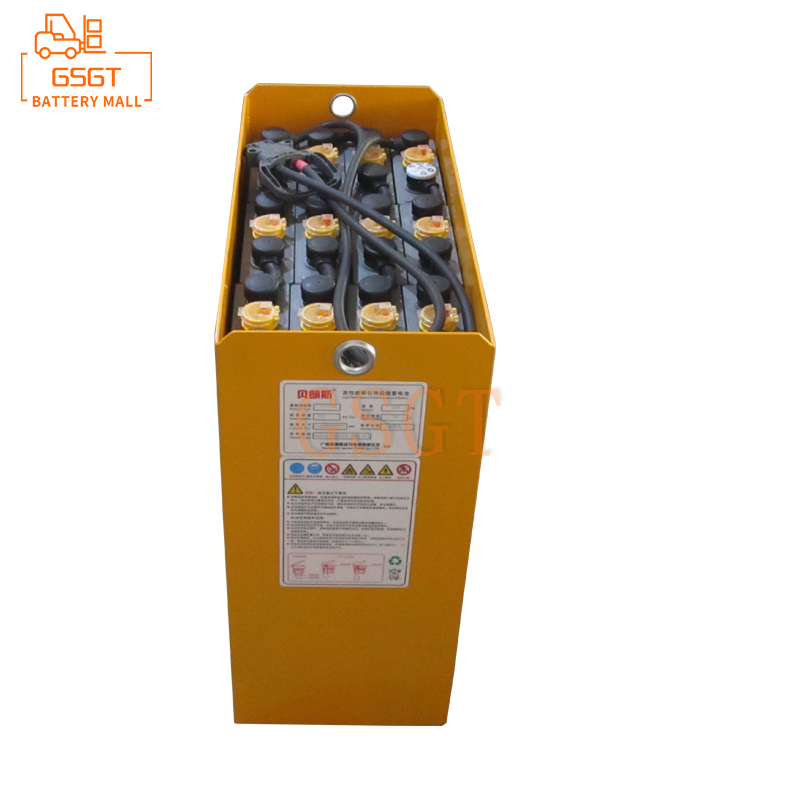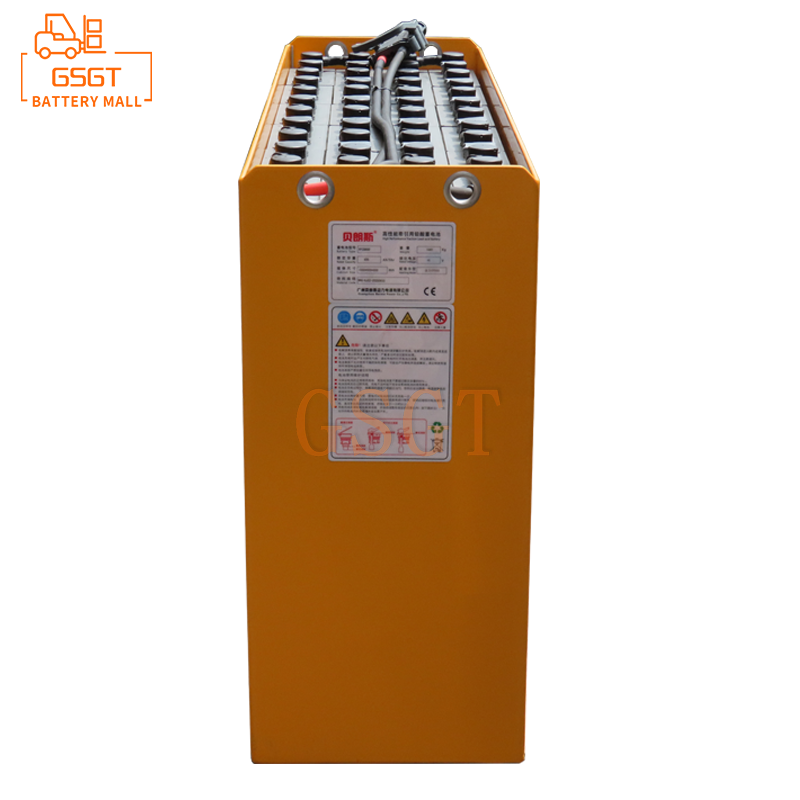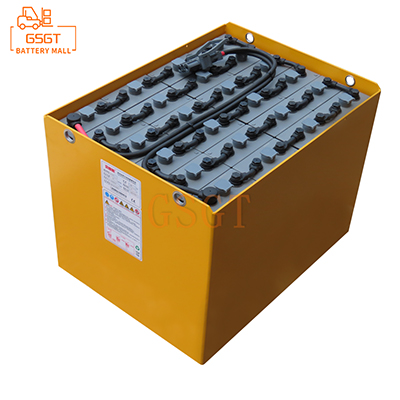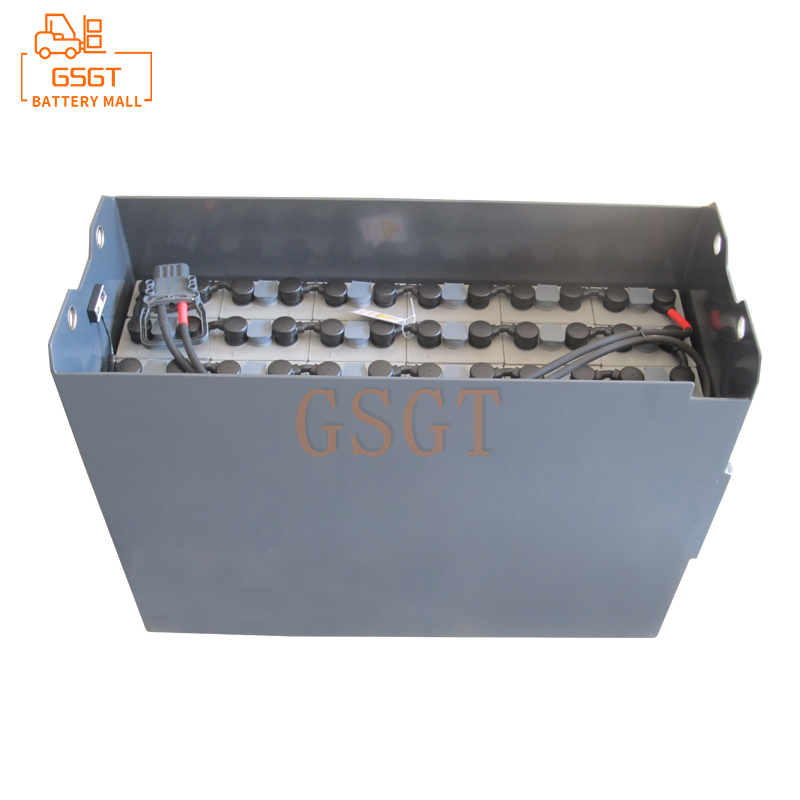Time:2025-06-10 09:44:13
Browse:588
The basic principle of lead-acid batteries and their status in the forklift field
Since its invention in 1859, lead-acid batteries have occupied an important position in the industrial field, especially in the power supply of forklifts, thanks to their significant advantages such as abundant raw material sources, mature technology and low price. Its working principle is based on the chemical reaction between the positive and negative plates and the electrolyte. The main component of the positive plate is lead dioxide, the negative plate is spongy lead, and the electrolyte is dilute sulfuric acid solution. During the discharge process, lead atoms at the negative electrode lose electrons to become lead ions, which combine with sulfate ions in the electrolyte to form lead sulfate precipitates on the negative electrode plate. Lead dioxide at the positive electrode, after gaining electrons, reacts with hydrogen ions and sulfate ions in sulfuric acid to form lead sulfate and water as well. This chemical reaction process converts chemical energy into electrical energy to power forklifts.
In forklift application scenarios, lead-acid batteries, with their ability to provide a large starting current and stable voltage output, meet the frequent starting, acceleration and heavy object handling requirements of forklifts. Especially in the field of heavy-duty forklifts, lead-acid batteries have become the preferred power source for many enterprises due to their reliability and cost-effectiveness. However, with the continuous improvement of industrial production efficiency requirements and the increasingly strict environmental protection regulations, the sustained output performance of lead-acid batteries in heavy-duty forklifts is facing many challenges.
The operational characteristics of heavy-duty forklifts pose challenges to the continuous output of lead-acid batteries
High load demand and energy output limitations
Heavy-duty forklifts usually need to handle several tons or even tens of tons of goods, which places extremely high demands on the battery's instantaneous discharge capacity and continuous energy output. In actual operation, when forklifts are in conditions such as starting, accelerating and climbing slopes, the battery needs to be able to provide a large amount of electrical energy quickly to overcome the huge load resistance. When confronted with long-term, high-intensity heavy-load operations, lead-acid batteries may not be able to continuously provide sufficient energy, resulting in insufficient power for forklifts and a decline in operational efficiency.
Battery life attenuation caused by frequent charge and discharge cycles
The working nature of heavy-duty forklifts determines that their batteries need to undergo frequent charge and discharge cycles. After each discharge, chemical reactions occur between the plates and the electrolyte inside the battery, and the active substances on the plates gradually deplete, resulting in a decrease in battery capacity. As the number of charge and discharge cycles increases, the battery life gradually shortens. The battery may need to be replaced in a relatively short period of time. This not only increases the operating costs but also prolongs the forklift's downtime due to battery replacement, affecting the production progress. For instance, in some manufacturing factories, heavy-duty forklifts need to carry out a large amount of raw material handling work every day. The battery may go through multiple charge and discharge cycles every day. After a period of use, the battery capacity drops significantly, and the forklift's endurance and power performance are severely affected, forcing the battery to be replaced in advance.
The influence of working environment factors on battery performance
Temperature influence: Heavy-duty forklifts often operate in various complex environmental temperatures. In high-temperature environments, the evaporation rate of the electrolyte in lead-acid batteries accelerates, the corrosion of the plates intensifies, and the internal resistance of the battery increases. This can lead to an increase in the battery's self-discharge rate, a decrease in capacity, and may even cause safety issues such as thermal runaway. On the contrary, in a low-temperature environment, the viscosity of the electrolyte increases, the diffusion rate of ions slows down, and the chemical reaction rate of the battery decreases, resulting in a significant drop in the battery's output voltage and capacity. For heavy-duty forklifts operating in low-temperature environments such as cold storage facilities, when the ambient temperature drops below 0℃, the available capacity of lead-acid batteries may decrease by 30% to 50%, seriously affecting the normal operation of the forklifts.
Vibration and shock: In some operation scenarios, such as construction sites and mines, heavy-duty forklifts will be subject to significant vibration and shock during operation. These mechanical external forces may cause the plates inside the battery to deform and the active substances to fall off, thereby affecting the battery's performance and lifespan. When exposed to vibration and shock for a long time, the connection parts of the battery may become loose, resulting in an increase in contact resistance, further reducing the output efficiency of the battery and even causing electrical faults.
Unlock the strategy for the continuous output of lead-acid batteries on heavy-duty forklifts
Improvement of battery technology
Optimization of plate materials and structures: Develop new types of plate materials, such as using high-performance alloy materials like lead-calcium alloy to replace traditional lead-antimony alloy plates. Lead-calcium alloy plates have better corrosion resistance, which can effectively reduce the corrosion and deformation of the plates during charging and discharging, thereby extending the battery life. Meanwhile, optimizing the structural design of the plates, increasing their surface area, and enhancing the utilization rate of active substances can help improve the battery's high-current discharge capacity and energy output efficiency. For instance, by adopting a special pressing process, a porous structure is formed on the surface of the plates, increasing the contact area between the active material and the electrolyte. This can significantly enhance the battery's instantaneous discharge performance and meet the demand for high current during the start-up and acceleration of heavy-duty forklifts.
Electrolyte optimization: Improving the formula of the electrolyte and adding special additives, such as stannous sulfate, can suppress the sulfation of the negative plate, enhance the battery's charge acceptance capacity and cycle life. Meanwhile, adjust the density and concentration of the electrolyte to ensure that it maintains good ion conduction performance under different working environment temperatures. For instance, in a high-temperature environment, appropriately reducing the density of the electrolyte can decrease the corrosion and self-discharge of the plates. In a low-temperature environment, increasing the concentration of the electrolyte can enhance its conductivity and improve the low-temperature performance of the battery. In addition, using colloidal electrolyte instead of traditional liquid electrolyte can effectively prevent electrolyte leakage, enhance the safety and stability of the battery. Meanwhile, the gel-like structure of colloidal electrolyte helps to reduce the shedding of active substances and extend the battery life.
Upgrade of the charging management system
Implementation of equalization charging technology: During the use of lead-acid battery packs, the performance of each individual battery will gradually vary, leading to a decline in the overall performance of the battery pack. Equalization charging technology, by monitoring and controlling each individual battery separately, keeps the voltage, capacity and temperature of each individual battery in the battery pack consistent, avoiding overcharging or undercharging of individual batteries, thereby extending the service life of the entire battery pack and improving its continuous output performance. This technology can effectively enhance the consistency of battery packs and improve the overall performance of lead-acid batteries in heavy-duty forklifts.
Maintenance strategy optimization
Regular inspection and maintenance: Establish a strict regular inspection system for lead-acid batteries, and regularly test parameters such as battery voltage, electrolyte density, plate condition, and internal resistance to promptly identify and address any battery issues. At the same time, regular deep discharge and charging maintenance of the battery, known as "activation" treatment, can effectively restore battery capacity and extend battery life.
Operator training: Strengthen the training of heavy-duty forklift operators to enhance their awareness of the correct use and maintenance of lead-acid batteries. The training content includes reasonably controlling the operation intensity and working hours of forklifts to avoid excessive battery discharge. Operate the charging equipment correctly and charge in accordance with the prescribed charging process. Regularly clean and maintain the battery to prevent the accumulation of dust and debris, which may affect battery heat dissipation and other aspects. By enhancing the professional quality of operators, battery damage caused by human factors can be effectively reduced, ensuring the continuous and stable output of lead-acid batteries on heavy-duty forklifts.
Conclusion
The continuous output performance improvement of lead-acid batteries in heavy-duty forklifts is a systematic project, involving multiple aspects such as battery technology improvement, charging management system upgrade, thermal management system refinement, and maintenance strategy optimization. By adopting advanced plate materials and structures, optimizing the electrolyte formula, applying intelligent charging algorithms and equalization charging technologies, improving the thermal management system, and strengthening maintenance management, the energy output efficiency of lead-acid batteries on heavy-duty forklifts can be effectively enhanced, the battery life can be prolonged, and the adaptability of the battery in different working environments can be strengthened. So as to meet the growing demand for efficient operation of heavy-duty forklifts. Although lead-acid batteries have certain limitations when facing competition from emerging battery technologies, through continuous technological innovation and performance optimization, they will still play an important role in the heavy-duty forklift field for some time to come, providing reliable and economical power support for the logistics and handling links in industrial production.

$1105

$3810

$3405

$2040

MESSAGE
Professional And Efficient
Security
Affordable Price
Professional Services